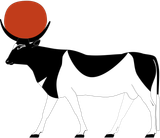Search Results
7/19/2025, 11:49:18 PM
>>40758449
>For much of their history, the Egyptians were accommodating of other people’s gods and always ready to receive additions to their own pantheon. They received but they did not feel any great need to give: hence there was no real attempt to persuade non-Egyptians to worship Egyptian gods. In ancient Egypt the basis of religion was not belief but cult, particularly the local cult which meant more to the individual. Thus, many deities flourished simultaneously and the Egyptians were seemingly ever-ready to adopt a new god or to change their views about the old.
>The predominant characteristics of much of Egyptian religion were animism, fetishism and magic. There was also the belief that certain animals possessed divine powers – the cow, for example, represented fertility, the bull virility – which led to the cult of sacred animals, birds and reptiles, each of which was considered to be the manifestation on earth of a divine being. It was this aspect of Egyptian religion more than any other that the Greeks found curious and the Romans horrifying. Both Greeks and Romans were happy about the polytheism, being polytheistic themselves. However, their own gods, although they were celestial, immortal beings, were nevertheless recognizably human: they had human shapes, and were possessed of human emotions and frailties. But the Egyptian gods! The most cursory look at reliefs carved on temple walls showing representations of gods revealed one with the body of a man and the head of a hawk; another with the body of a man and the head of a jackal. Yet another man seemed to have a beetle in place of a head, while the woman standing next to him had the head of a lioness. They were all gods; and so were the vultures and cobras hovering in attendance on them.
>Inside the temples, the Egyptians kept real live cats, bulls, ibises or hawks, and worshipped them as gods; and when they died, mummified and buried them as they did their kings.
>For much of their history, the Egyptians were accommodating of other people’s gods and always ready to receive additions to their own pantheon. They received but they did not feel any great need to give: hence there was no real attempt to persuade non-Egyptians to worship Egyptian gods. In ancient Egypt the basis of religion was not belief but cult, particularly the local cult which meant more to the individual. Thus, many deities flourished simultaneously and the Egyptians were seemingly ever-ready to adopt a new god or to change their views about the old.
>The predominant characteristics of much of Egyptian religion were animism, fetishism and magic. There was also the belief that certain animals possessed divine powers – the cow, for example, represented fertility, the bull virility – which led to the cult of sacred animals, birds and reptiles, each of which was considered to be the manifestation on earth of a divine being. It was this aspect of Egyptian religion more than any other that the Greeks found curious and the Romans horrifying. Both Greeks and Romans were happy about the polytheism, being polytheistic themselves. However, their own gods, although they were celestial, immortal beings, were nevertheless recognizably human: they had human shapes, and were possessed of human emotions and frailties. But the Egyptian gods! The most cursory look at reliefs carved on temple walls showing representations of gods revealed one with the body of a man and the head of a hawk; another with the body of a man and the head of a jackal. Yet another man seemed to have a beetle in place of a head, while the woman standing next to him had the head of a lioness. They were all gods; and so were the vultures and cobras hovering in attendance on them.
>Inside the temples, the Egyptians kept real live cats, bulls, ibises or hawks, and worshipped them as gods; and when they died, mummified and buried them as they did their kings.
Page 1
